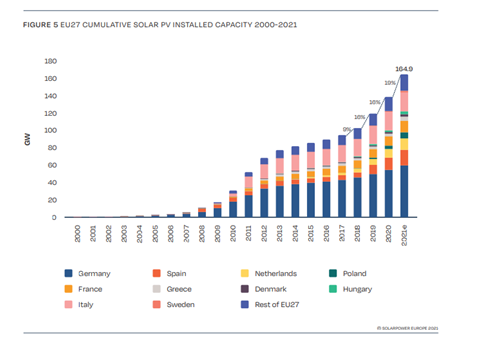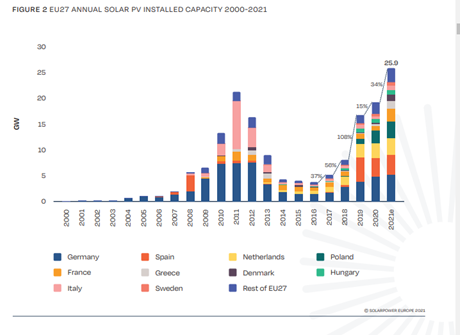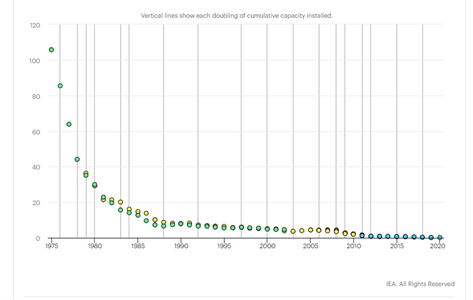Written by Giannis Katsos.
Solar power has been in incubation for many years, from the discovery of the photovoltaic effect by Edmond Becquerel in 1839, to the making of the first solar panel by Bell Labs in 1954. It has now emerged into a mainstream electricity source and Europe aspires to lead in its expansion, with a 45% renewable energy target by 2030. But how have we got here?

Germany was a pioneer in the field, laying the groundwork with the Electricity Feed-in Act of 1991 (the first renewable electricity feed-in tariff scheme) which kickstarted investment in solar and wind by ensuring a long-term stable price for renewable energy. In 1999 it also launched the 100,000 Roofs programme which provided low-interest loans for solar panels, resulting in 261 MW of installations by 2003. Although this amount is not game-changing today, it was much more significant at the time given the early stage the industry was in and set a precedent for further government-backed PV programmes.
Spain, one of the European countries receiving the most sunlight, was also quick to embrace the solar energy revolution. Government subsidies through feed-in tariffs led to a take-off of the solar industry in 2008, particularly in concentrated solar power, in which Spain is a global leader. The termination of these policies combined with a so-called ‘sun tax’ put a stop to growth in the solar sector in the mid 2010s and this is regarded as an example of what a government should avoid to encourage renewables development. But growth has resumed in recent years after such restrictions were lifted and public auctions for renewable electricity were held.
 The coupling of plummeting cost of PV panels and their rising efficiency has been a key driver of growth both in Europe and globally. To illustrate the point, consider that in 2012, the record was 17.8% efficiency, but in 2020, 47.1% was achieved (though these involve use of very expensive materials; solar panels in commercial use today tend to be in the 15-20% range). In the US it cost an average of $8.50 / W to install PVs in 2009. Today that has fallen to just $2.80 / W and the pattern has been similar in Europe. And still, there is potential for further gains in price and efficiency as uptake of solar power continues to expand.
The coupling of plummeting cost of PV panels and their rising efficiency has been a key driver of growth both in Europe and globally. To illustrate the point, consider that in 2012, the record was 17.8% efficiency, but in 2020, 47.1% was achieved (though these involve use of very expensive materials; solar panels in commercial use today tend to be in the 15-20% range). In the US it cost an average of $8.50 / W to install PVs in 2009. Today that has fallen to just $2.80 / W and the pattern has been similar in Europe. And still, there is potential for further gains in price and efficiency as uptake of solar power continues to expand.

Solar power began taking off in the late 2000s, with a high rate of growth until the period 2013-2017, when the pace slowed. Something which contributed to this notable dent was the EU’s anti-dumping tariffs on Chinese solar panel importers (China is the world’s biggest manufacturer of these), brought in in 2013 to halt an inflow of very cheap panels they feared would outcompete EU companies. The tariffs were withdrawn in 2018 and expansion of PVs accelerated. The rate of growth even rose by 15% during the pandemic in 2020 – contrary to expectations – demonstrating the resilience of the sector. 2021 was a record-breaking year: an all-time high of 25.9 GW were deployed while 25 out of 27 EU states deployed more solar than the previous year.
Today, Germany is the major PV power in Europe, with capacity expanding by 5.3 GW in 2021, followed by Spain and the Netherlands. Greece surged to 6th place, with new installations reaching 1.6 GW in 2021 from 0.5 GW in 2020. This mainly took the form of smaller projects up to 500kW, with those in the megawatt scale expected to come to fruition in the years to come. The European solar industry is no longer dependent on state subsidies but is now a self-sufficient energy sector and one of the most profitable forms of electricity generation. The time is ripe for investment.

